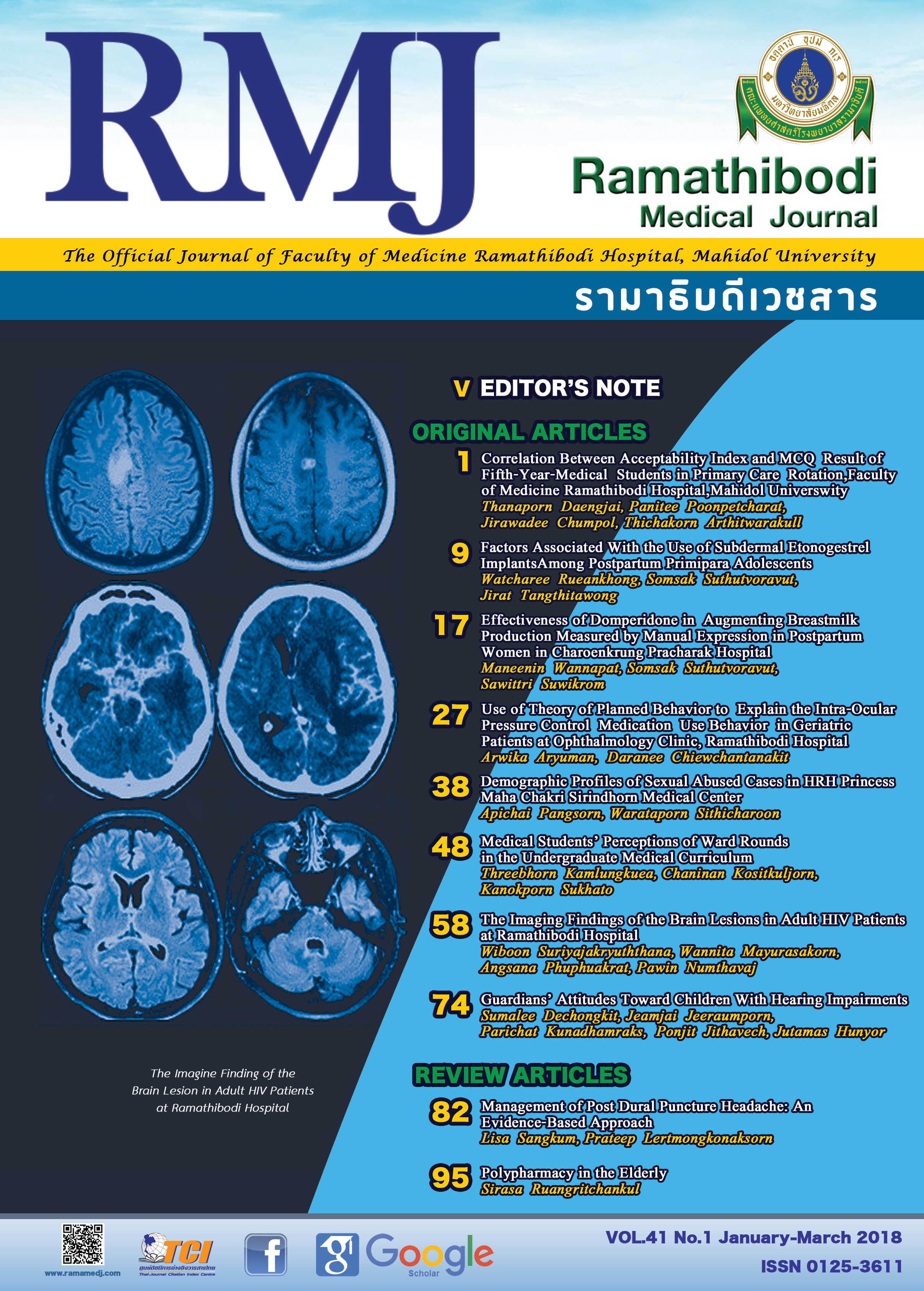Effectiveness of Domperidone in Augmenting Breastmilk Production Measured by Manual Expression in Postpartum Women in Charoenkrung Pracharak Hospital
DOI:
https://doi.org/10.14456/rmj.2018.3Keywords:
Domperidone, BreastfeedingAbstract
Background: Breastmilk is the ideal food for infants. Domperidone was found to increase breastmilk production but its use is still controversial. Most of the studies used electric breast pump to collect breastmilk. However, manual expression of breastmilk has some advantages over electric breast pump.
Objective: To study effectiveness of domperidone in increasing breastmilk production among postpartum women by using manual expression to collect breastmilk.
Methods: This study recruited 50 postpartum women who had term spontaneous normal vaginal delivery in Charoenkrung Pracharak Hospital from September 1, 2015 to November 30, 2015. The participants were randomly assigned to receive domperidone or placebo, 25 women in each group. Drugs were first given to postpartum women at 24 hours after delivery. Breastmilk was collected by manually expression at 24 hours after delivery before receiving drugs, then at 48 hours, 72 hours and 96 hours after delivery. Chi-Square test and Mann-Whitney U test were used for hypothesis testing and the statistical significance was set at P < 0.05.
Results: The median volume of breastmilk in both groups at 24 hours after delivery and before receiving drugs were 2 milliliters in domperidone group and 1 milliliter in placebo group. Breastmilk median volume increased in both groups afterwards. At 48 hours after delivery, the volumes were 8 and 3 milliliters in domperidone and placebo group respectively. At 72 hours, the volumes were 15 and 10 milliliters, at 96 hours, the volumes were 35 and 15 milliliters in groups respectively. The differences were statistically significant (P < 0.05). There was no side effect of domperidone among the postpartum women in the domperidone group.
Conclusion: Domperidone effectively increased more breastmilk production measured by manual expression than placebo.
References
Gartner LM, Morton J, Lawrence RA, et al. Breastfeeding and the use of human milk. Pediatrics. 2005;115(2):496-506.
Dewey KG, Heinig MJ, Nommsen-Rivers LA. Differences in morbidity between breast-fed and formula-fed infants. J Pediatr. 1995;126(5 Pt 1):696-702.
Howie PW, Forsyth JS, Ogston SA, Clark A, Florey CD. Protective effect of breastfeeding against infection. BMJ. 1990;300(6716):11-16.
Uauy RD, Birch DG, Birch EE, Tyson JE, Hoffman DR. Effect of dietary omega-3 fatty acids on retinal function of very-low-birth-weight neonates. Pediatr Res. 1990;28(5):485-492.
Horwood LJ, Darlow BA, Mogridge N. Breast milk feeding and cognitive ability at 7-8 years. Arch Dis Child Fetal Neonatal Ed. 2001;84(1):F23-F27.
Oddy WH, Kendall GE, Blair E, et al. Breastfeeding and cognitive development in childhood: a prospective birth cohort study. Paediatr Perinat Epidemiol. 2003;17(1):81-90.
Rosenbauer J, Herzig P, Giani G. Early infant feeding and risk of type 1 diabetes mellitus-a nationwide population-based case-control study in pre-school children. Diabetes Metab Res Rev. 2008;24(3):211-222.
Rudnicka AR, Owen CG, Strachan DP. The effect of breastfeeding on cardiorespiratory risk factors in adult life. Pediatrics. 2007;119(5):1107-1115.
Palda VA, Guise J-M, Wathen CN, and with The Canadian Task Force on Preventive Health Care. Interventions to promote breast-feeding: applying the evidence in clinical practice. CMAJ. 2004;170(6):976-978. doi:10.1503/cmaj.1031197.
Chalmers B, Levitt C, Heaman M, et al. Breastfeeding rates and hospital breastfeeding practices in Canada: a national survey of women. Birth. 2009;36(2):122-132. doi: 10.1111/j.1523-536X.2009.00309.x.
Walters D, Horton S, Siregar AY, et al. The cost of not breastfeeding in Southeast Asia. Health Policy Plan. 2016;31(8):1107-1116. doi:10.1093/heapol/czw044.
Hurst NM. Recognizing and treating delayed or failed lactogenesis II. J Midwifery Womens Health. 2007;52(6):588-594.
Palda VA, Guise JM, Wathen CN, and the Canadian Task Force on Preventive Health Care. Interventions to promote breastfeeding: updated recommendations from the Canadian Task Force on Preventive Health Care. London, Ontario: Canadian Task Force on Preventive Health Care (CTFPHC). 2003:15.
Zuppa AA, Sindico P, Orchi C, Carducci C, Cardiello V, Romagnoli C. Safety and efficacy of galactogogues: substances that induce, maintain and increase breast milk production. J Pharm Pharm Sci. 2010;13(2):162-174.
Academy Of Breastfeeding Medicine Protocol Committee. ABM Clinical Protocol #9: Use of galactogogues in initiating or augmenting the rate of maternal milk secretion (first revision January 2011). Breastfeed Med. 2011;6(1):41-49. doi:10.1089/bfm.2011.9998.
da Silva OP, Knoppert DC, Angelini MM, Forret PA. Effect of domperidone on milk production in mothers of premature newborns: a randomized, double-blind, placebo-controlled trial. CMAJ. 2001;164(1):17-21.
Wan EW, Davey K, Page-Sharp M, Hartmann PE, Simmer K, Ilett KF. Dose-effect study of domperidone as a galactagogue in preterm mothers with insufficient milk supply, and its transfer into milk. Br J Clin Pharmacol. 2008;66(2):283-289. doi:10.1111/j.1365-2125.2008.03207.x.
Osadchy A, Moretti ME, Koren G. Effect of domperidone on insufficient lactation in puerperal women: a systematic review and meta-analysis of randomized controlled trials. Obstet Gynecol Int. 2012;2012:642893. doi:10.1155/2012/642893.
Rachuso S. Effectiveness of domperidone in breast milk production augmentation of term cesarean deliveries mothers. Buddhachinaraj Med J. 2009;26(2):168-172.
Jantarasaengaram S, Sreewapa P. Effects of domperidone on augmentation of lactation following cesarean delivery at full term. Int J Gynaecol Obstet. 2012;116(3):240-243.
Campbell-Yeo ML, Allen AC, Joseph KS, Ledwidge JM, Allen VM, Dooley KC. Study protocol: a double blind placebo controlled trial examining the effect of domperidone on the composition of breast milk [NCT00308334]. BMC Pregnancy Childbirth. 2006;6:17. doi:10.1186/1471-2393-6-17.
Lawrence RA, Lawrence RM. Breastfeeding: a guide for the medical profession. 8th ed. Philadelphia, PA: Elsevier Mosby; 2016.
Paul VK, Singh M, Deorari AK, Pacheco J, Taneja U. Manual and pump methods of expression of breast milk. Indian J Pediatr. 1996;63(1):87-92.
Slusher TM, Slusher IL, Keating EM, et al. Comparison of maternal milk (breastmilk) expression methods in an African nursery. Breastfeed Med. 2012;7(2):107-111. doi:10.1089/bfm.2011.0008.
Boo NY, Nordiah AJ, Alfizah H, Nor-Rohaini AH, Lim VK. Contamination of breast milk obtained by manual expression and breast pumps in mothers of very low birthweight infants. J Hosp Infect. 2001;49(4):274-281.
Downloads
Published
How to Cite
Issue
Section
License
Copyright (c) 2018 By the authors. Licensee RMJ, Faculty of Medicine Ramathibodi Hospital, Mahidol University, Bangkok, Thailand

This work is licensed under a Creative Commons Attribution-NonCommercial-NoDerivatives 4.0 International License.

















